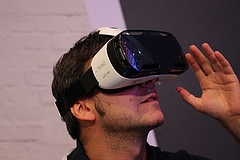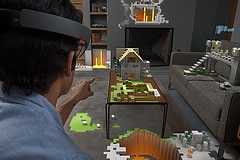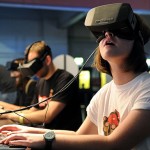 The Virtual and Augmented Reality hype trains continue to grow, promising a greatly enhanced version of daily reality that will be in our hands (and on our heads) within the next year or two. Samsung’s launch of the Gear VR is the first truly viable commercial platform, coming out of a close partnership with Oculus VR; whilst Microsoft has put its contender well and truly into the ring with the HoloLens (making sense of that massive Minecraft buy out!).
The Virtual and Augmented Reality hype trains continue to grow, promising a greatly enhanced version of daily reality that will be in our hands (and on our heads) within the next year or two. Samsung’s launch of the Gear VR is the first truly viable commercial platform, coming out of a close partnership with Oculus VR; whilst Microsoft has put its contender well and truly into the ring with the HoloLens (making sense of that massive Minecraft buy out!).
Facebook bought out Oculus VR, Google has put down half a billion dollars for Magic Leap, and Steam will soon be following with announcements of their own in these areas (Update: Details of the partnership with HTC are now available!). It’s quite clear that many of the top-tier players in the technology industry see these platforms as the future. There are two primary approaches to this new field – virtual and augmented – so which one will come out on top?
To begin with, it’s obvious that the true answer is that both have immense potential to be successful as mainstream commercial products. The future will most likely prove to be a combination of an augmented experience of daily activities, with access to the virtual creation of new worlds and non-locational forms of interaction. Indeed, it’s likely that some devices will be able to do both. The two formats, though, ultimately serve different purposes and certainly have quite different strengths and weaknesses. It is also worth considering that in the minds of the general consumer these platforms will be conflated in the short term (say the next five to ten years) until there is enough differentiation for them to be seen as two separate mediums. So it’s still worth considering which format might come out ahead and most effectively forge new consumer and industry spaces.
Augmented reality is probably the path that is already most visible to the public eye. It’s a technology that we’ve had in limited form on our smartphones for a number of years, and the spectacle (pun intended!) of Google Glass shows that there was a lot of interest in the technology. Albeit an interest that quickly turned to condemnation, to the extent that ‘glassholes’ became a widely recognised term. However, a large part of the problem with Google Glass seemed to be linked to its ‘always on’ ethos and the recent displays of HoloLens from Microsoft (and its form/design) are going for a much more purpose-driven approach that will sidestep legitimate privacy concerns. Placing the interactive space within the real world also overcomes many of the concerns about social isolation, and is arguably an easier format to promote co-operative experiences with, but it does limit the creative potential and will lead developers down particular avenues.
AR is also something that is more likely to appeal to corporate interests as it readily allows traditional-yet-novel modes of advertising to be mapped onto the user experience. This is both a blessing and a curse, of course, but the viability of new platforms undeniably depends a great deal on the amount of investment into content that can be gathered. Augmented reality does therefore seem to have an advantage from the outset, primarily because of its familiarity and cultural immediacy. It’s a format that is well rehearsed in films and entertainment, and the user experience is a more natural progression from what we are used to that should promote a quick take-up of the technology if it can find an appropriate distributive outlet – and Microsoft has a better chance than almost anybody of being able to do that.
 We have to keep in mind, thought, that it’s also something that has recently failed spectacularly with Google Glass. Overcoming that stigma might prove difficult for a fickle consumer base. ‘Always on’ functionality will likely be a long way off, but as an item that promotes new forms of entertainment, communication and information access there is a lot of potential to readily create new market space.
We have to keep in mind, thought, that it’s also something that has recently failed spectacularly with Google Glass. Overcoming that stigma might prove difficult for a fickle consumer base. ‘Always on’ functionality will likely be a long way off, but as an item that promotes new forms of entertainment, communication and information access there is a lot of potential to readily create new market space.
Virtual reality, on the other hand, is still very much in the eyes of the public a highly technical format. Samsung’s Gear VR, and smartphone integration in general, is a clever way to overcome this barrier and create a more accessible medium – but for the foreseeable future it seems that VR is going to be an enthusiasts product. Despite this, the impact that it can make on a new user is undeniably stronger than AR can muster. The ability to be transported into situations that are wholly unlike our day-to-day existence is what brings virtual worlds to the forefront of people’s curiosity and it is this holodeck-like capability that is the medium’s biggest advantage. The reactions that I’ve seen demoing the Oculus Rift DK2 for friends and family really brings this point home – people are blown away by the experience. That is, if they don’t happen to get motion sick during it.
It’s a relatively unspoken Achilles heel of the technology in its current form, but a significant proportion of users suffer from the effects of motion sickness and until this can be overcome (which the industry is pretty confident it can be) then the format won’t be ready for full consumer release. It’s too risky a proposition, as the predatory media will pounce on the issue and reports of high return rates won’t make for a good commercial narrative. When combined with the need for high-end computer specs to properly operate a VR system, along with the challenge of adequate control schemes, it’s a killer combination that I think will delay the widespread release of commercial VR (including Oculus CV1) for at least the next two years. It will be worth the wait though, because unlike its augmented cousin Virtual Reality really does open us up to completely new modes of creative expression – allowing the formation of a deep connection to a vast range of different experiences and identities.
If I had to call it, then I would say that Augmented Reality will be the first to hit the ground running – primarily because it is easier to relate to, and more immediately mainstream in its application (AR + Minecraft = mountains of money). Virtual Reality will really find traction on the back of this success, with a second wave of widespread acceptance as the platforms become more self-reliant (i.e. not dependent on a high-end PC) and the industry is able to crack the sickness/control issues that will plague initial phases.
Ultimately, though, I think we can be confident that both technologies are going to be successful (given enough time) and are going to change the way we interact with the world around us and the boundaries of our imaginative expression. At this point it’s worth rejoicing in the fact that, unlike versions of these technologies that have come in decades past, we’ve finally reached the point where these platforms are viable and primed for success. As I’ve said many times on this blog recently – the future is now!




